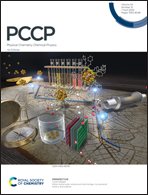The experimental average refractive index of liquid crystals and its prediction from the anisotropic indices†
Abstract
Anisotropic optical properties of liquid crystals (LC), combined with their fluidity, are crucial for the development of new liquid crystal devices and applications. The optical anisotropy implies an existence of various refractive indices that depend on the direction of light oscillation relative to the director vector. For some applications, it is, however, necessary to estimate an average refractive index (nav) for the liquid–crystalline material, which is commonly effected through models of combination of the anisotropic refractive indices. The validity of these models lacks proof as the experimental average refractive index for anisotropic fluids has not been published. This article reports an experimental strategy to measure nav of liquid crystals; the method is based on generating multiple orientations of the liquid crystal molecules through their isotropization in mixtures with isotropic liquids. The refractive index of an isotropic mixture is measured; then the apparent refractive index of the liquid crystal is extracted using validated combination models of refractive indices in mixtures. The method was assessed with two nematic liquid crystals (5CB and MBBA) mixed with several isotropic liquids. The results indicate that the average refractive index of a LC is an extrapolation, in the nematic range of temperatures, of the index variation above the nematic–isotropic transition. A new theoretical model to predict the average refractive indices of liquid crystals was developed. Compared with the traditional formulae, the new model represents a significant improvement for the calculation of nav.

- This article is part of the themed collection: Celebrating Latin American Chemistry


 Please wait while we load your content...
Please wait while we load your content...